#Eric Carle museum
Explore tagged Tumblr posts
Text

“All men care about is cars”
12 notes
·
View notes
Text
The Eric Carle Museum of Picture Book Art included Mika Song’s and my LOVE, SOPHIA ON THE MOON in their new exhibition, “Dear Reader: Picture Books and Letter Writing,” and it’s more thrilling than a moonicorn ride

#eric carle#Eric Carle museum#picture book writer#picture book illustration#love sophia on the moon#mika song#moonicorns#moon books#2020 picture books
5 notes
·
View notes
Text
Thankful Thursday
Hi everyone! We are joining Brian’s Thankful Thursday Blog Hop. I am thankful for school vacations. I was able to have the girls over on Monday. And on Wednesday, my mom and I met my niece, The Great One, Typhoid Mary and the boy at the Eric Carle Museum of Picture Book Art then we went out to lunch. There should be a school vacation every month. 🙂 I am also thankful that Michael’s Craft…
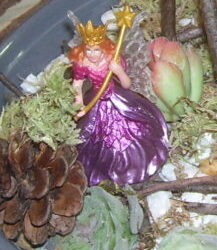
View On WordPress
#Brian&039;s Thankful Thursday Blog Hop#Eric Carle Museum#Friendly Fill-ins#The Great One#Typhoid Mary
0 notes
Photo

Yes, you can travel through reading. Sometimes, it’s fun to let reading inspire your travels. Around the world, there’s an array of museums dedicated to expanding authors’ worlds through real-world artifacts, contextual deep dives, and a pure dose of imagination. Whether you’re hoping to learn a bit more about your favorite piece of literature or simply looking to explore a location through a fresh set of eyes, these book-centric institutions are worth a visit.
(via 10 Museums for Book Lovers to Visit Across the Globe)
#shondaland#books#reading#book museum#sherlock holmes#book girl#Kadokawa Culture Museum#Laura Ingalls Wilder Museum#laura ingalls wilder#Eric Carle#The Writers’ Museum
2 notes
·
View notes
Note
::rolls up sleeves::
Alright, time for some Shire appreciation
Western Mass has:
The tallest mountain in Mass, Mt Greylock, which was the inspiration for Moby Dick (Melville’s home is in a nearby town and viewing a snow-covered Greylock gave him the idea for a white whale) as well as a poem by Oliver Wendell Holmes and a horror story by Nathaniel Hawthorne
The home of Norman Rockwell, now a museum, as well as dozens of locales (and people, although fewer as time goes by) featured in classic paintings of his
The homes of Edith Wharton, Emily Dickinson, and William Cullen Bryant, plus the Dr Seuss and Eric Carle Museums, Mass MoCA, and the Clarke Art Museum
The birthplace of basketball and basketball hall of fame as well as the locale of the first written evidence of baseball (sorry, Cooperstown fans, the Doubleday thing is a myth)
The hometowns of Penn Jillette, Misha Collins, Elizabeth Banks, plus the birthplace of Matthew Perry, and adopted hometown of James Taylor as well as numerous other celebs with seasonal homes in the area
A castle and a crapton of Gilded Era mansions
A Gilded Era theater that was hidden in the back of a paint store for half a century
Tanglewood
And, perhaps most importantly, the town with the highest number of lesbians per capita in the US (also, not coincidentally though less importantly, Smith College and a dozen or so other colleges that aren't UMass)
Official Post of Massachusetts
211 notes
·
View notes
Photo

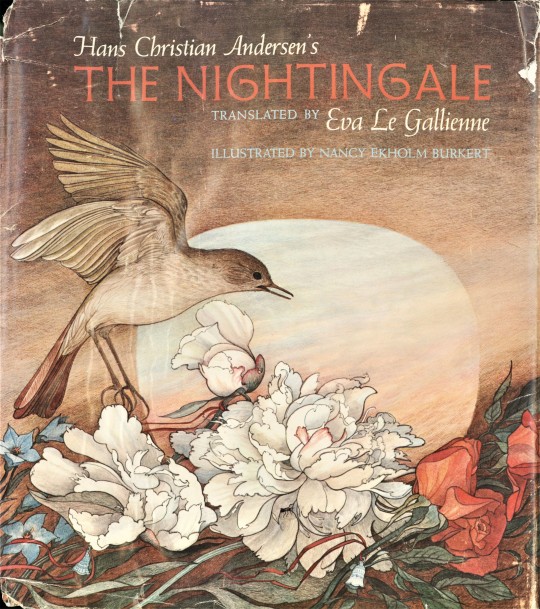
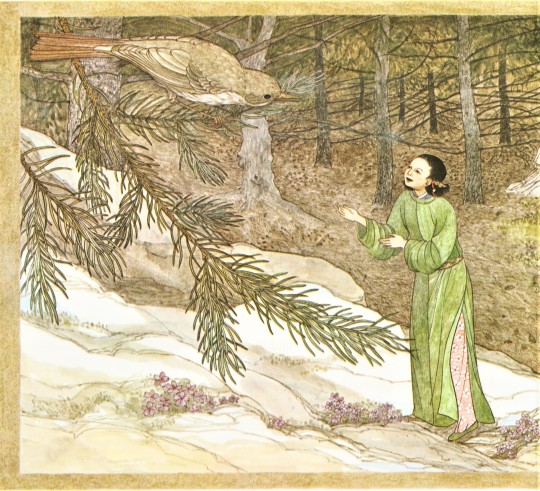
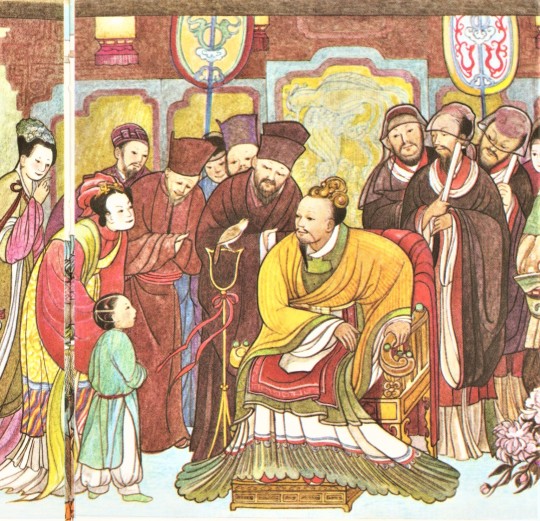



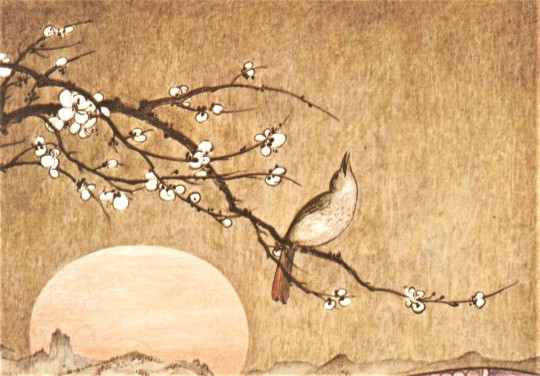
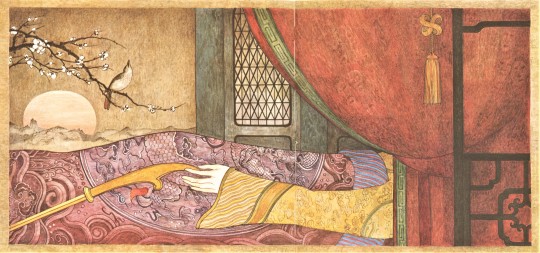
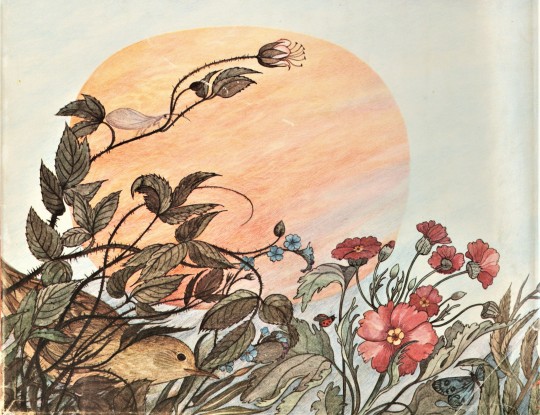
A Nancy Ekholm Burkert Feathursday
We begin the first #Feathursday of the new year with these illustrations by noted Milwaukee children’s-book illustrator Nancy Ekholm Burkert from Hans Christian Andersen’s story The Nightingale, translated by Eva Le Gallienne and published by Harper & Row in 1965.
The story, originally published in 1843, concerns an emperor of China and his beloved nightingale. When the emperor first encounters the bird, he is surprised that such beautiful notes would come from such a plain bird, but falls in love with the bird and its abilities. Soon, however, the emperor is gifted a bejeweled mechanical nightingale, which displaces the real one and eventually the nightingale is banished from court. A few years later, as the emperor lies dying, the loyal nightingale comes to visit and sing for its old friend. The song is so enchanting that even death stays its hand, the emperor recovers, and the strong bond between emperor and nightingale is restored.
We are humored that Andersen begins his tale by stating the obvious: “In China, you know, the Emperor is Chinese and all his subjects are Chinese too.” Burkert’s usual distinctive, intricate, and detailed style is present here, but this time her illustrations are strongly influenced by her particular fascination with Sung period Chinese painting. The color illustrations are presented in the book as traditional Chinee scroll paintings.
Nancy Ekholm Burkert has won numerous awards for her illustrations, including the Caldecott, New York Times Notable Book, Boston Globe-Horn Book, and Wisconsin Library Association Wisconsin Notable Authors. In addition, the Eric Carle Museum of Picture Book Art featured an exhibit of Burkert's work in 2003. She is a long-time Milwaukee-area resident and her husband Robert Burkert (1930-2019), was a long-time professor of fine arts here at UW-Milwaukee (1956-1993).

View more posts with work by Nancy Ekholm Burkert.
View more Feathursday posts.
#Feathursday#nightingales#folk tales#fables#Nancy Ekholm Burkert#Hans Christian Andersen#The Nightingale#Eva Le Gallienne#Harper & Row#illustrated books#children's books#Historical Curriculum Collection#birds#birbs!
272 notes
·
View notes
Text
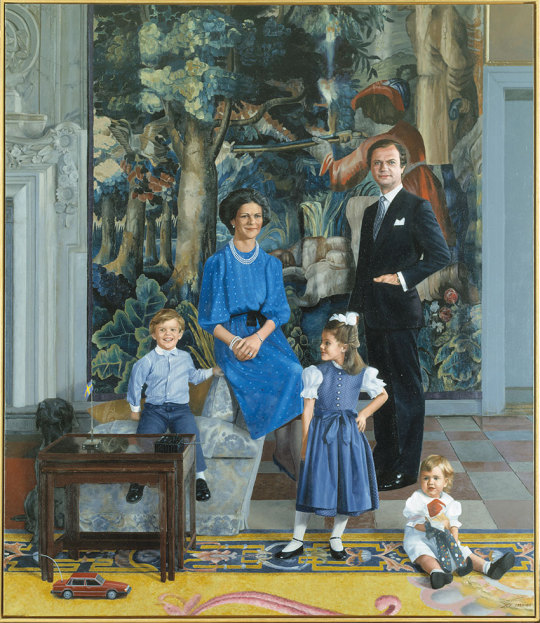
Carl XVI Gustaf with family by John-Erik Franzén (oil on canvas, 220 cm x 256 cm, dated 1984-85)
In the mid-1980s, the artist John-Erik Franzén was commissioned to portray the Royal Family for the portrait collection at Gripsholm Castle. The National Museum suggested Franzén after Gripsholm Castle commissioned the portrait. The Royal Family had seen Franzén's depiction of his son from 1981 and agreed to the National Museum's proposal.
The huge portrait was shown in the autumn of 1985 and caused a great stir. Criticism of the painting came from several quarters. Journalist and art critic Mats Arvidsson calls the painting one of the strangest he has seen in his entire life and says it is "full of painting technical errors".
Arvidsson exemplifies how the then seven-year-old Crown Princess Victoria is portrayed: "Little Victoria looks like she has been run over and stuck together wrongly in some emergency department."
John-Eric Franzén disagrees. He thinks the Victoria part of the large portrait was among the more successful parts: "I think she is the best part in the whole painting. It's funny when you get good characters - then people complain."
Though, Franzén says the Royal Family wanted him to repaint the part of the portrait that showed Victoria: "The Queen did not like that [Victoria] was so cocky. She wanted me to change it, but I didn't. Then you destroy the whole painting."
Photo: Nationalmuseum
#swedish royal family#kungafamiljen#king carl xvi gustaf#queen silvia#crown princess victoria#prince carl philip#princess madeleine#art history#official portrait#swedish royalty#swedish history#royal history#my upload
36 notes
·
View notes
Text
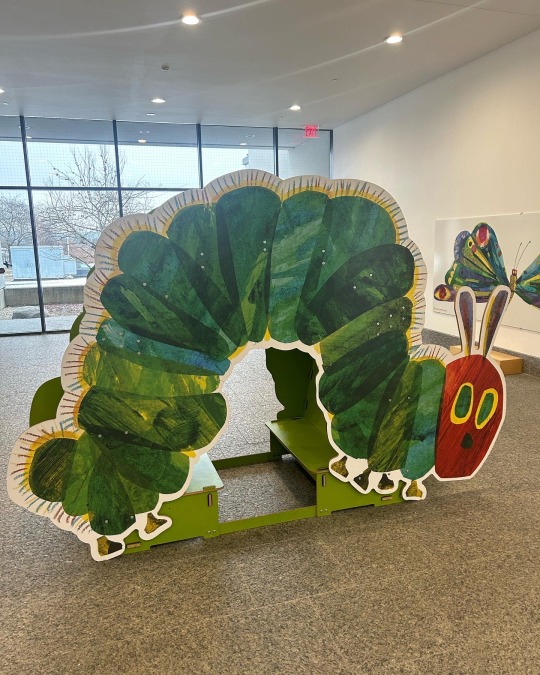
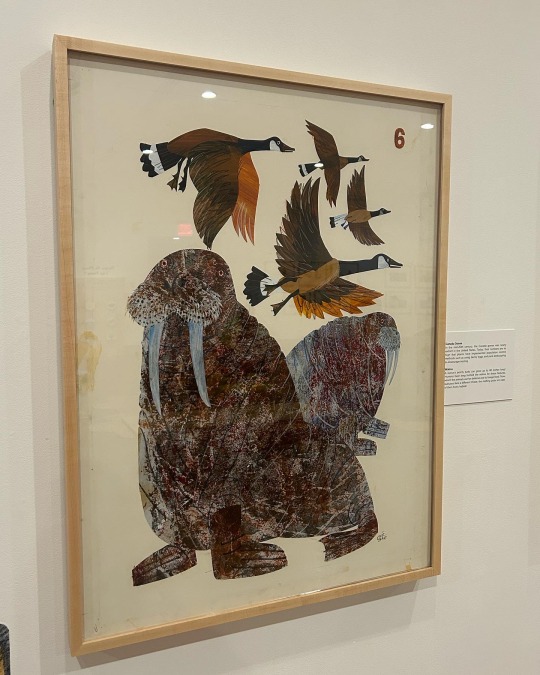


is everyone very jealous that i went to the eric carle museum of picture book art this weekend
7 notes
·
View notes
Text
I find Studio Ghibli movies deeply upsetting, they make me cry every single time and it's very painful. when I went to the Eric Carle museum I felt the same emotion I feel when I watch Studio Ghibli movies and I literally walked around galleries just crying trying not to make eye contact with anyone
8 notes
·
View notes
Text
The New York Times: Viewing the Civil Rights Movement Through Children’s Books.
“Picture the Dream,” on display at the New-York Historical Society, shows that children, far from being mere witnesses to the civil rights movement, have played central roles in it.
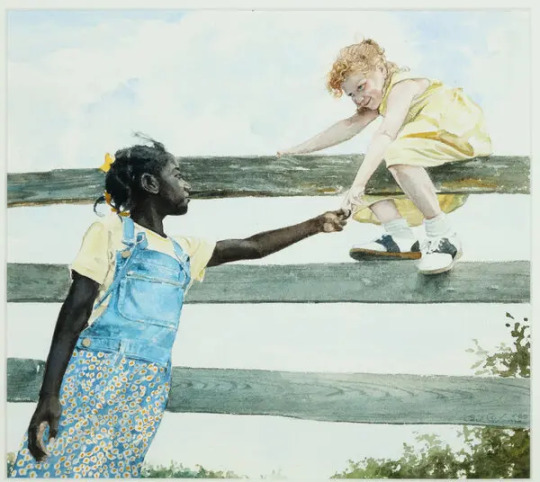
In a verdant rural setting, a weathered gray fence separates two girls, one Black, one white. The Black child extends her hand as the white girl, already straddling the fence’s top rail, reaches down. Although they barely grasp each other’s fingers, a viewer can sense their curiosity, their anticipation, their desire to surmount this barrier.
The scene, a watercolor by E.B. Lewis, is among the first works visitors encounter in “Picture the Dream: The Story of the Civil Rights Movement Through Children’s Books,” on view through July 24 at the New-York Historical Society. Created for Jacqueline Woodson’s book “The Other Side,” from 2001, the painting reflects two of this exhibition’s major themes: that progress stems from everyday, individual action as much as from collective effort; and that children, far from being mere witnesses to the civil rights movement, have played central roles in it.
“It was kids themselves who are on the sidewalks and streets, going to jail, getting bitten by dogs, taking the attack of billy clubs,” Andrea Davis Pinkney, the exhibition’s curator, said in an interview at the museum. “And that is happening right now. This minute.”
The show, which traces the civil rights movement from segregation to the present, captures those terrible moments, along with interludes of joy. Organized by the Eric Carle Museum of Picture Book Art in Amherst, Mass., and the High Museum of Art in Atlanta, “Picture the Dream” is the first exhibition to chronicle this history through children’s literature, Pinkney said. When the show debuted at the High Museum in August 2020, she added, some visitors thought George Floyd’s killing and the following protests had inspired it. But while “Picture the Dream” had been planned much earlier, subsequent events, including the racist massacre in Buffalo last month, have only sharpened its relevance.
“A picture book can never heal a tragedy,” Pinkney said, but “it can help us,” she added. Books allow families “to come together — an adult and a child — and say, ‘Let’s talk about this.’”
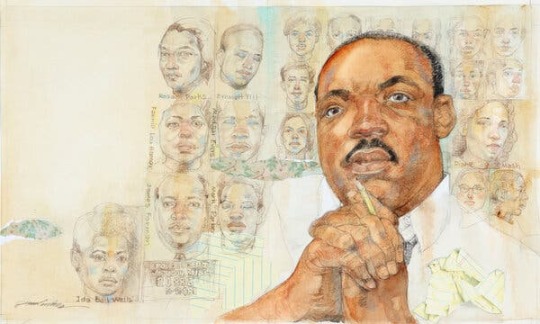
The potential to provoke such conversations was key to selecting the exhibition’s art, which comes from 60 books, nonfiction and fiction. Pinkney, an editor at Scholastic and an award-winning writer — she frequently collaborates with her husband, the illustrator Brian Pinkney — knew the show would commemorate milestones, including the Montgomery, Ala., bus boycott in 1955 and 1956 and the Selma-to-Montgomery marches in 1965. But in addition to honoring events, she wanted to feature a range of mediums and artists, including young illustrators like Vashti Harrison, as well as renowned figures like Faith Ringgold and Jerry Pinkney (her father-in-law).
The artworks, combined with explanatory text, constitute a kind of picture book themselves. Pinkney wrote the words as if she were creating a story, exhorting young museumgoers to get ready to walk: “Look down at your shoes. Are they sturdy?”
Pinkney and her collaborators also divided the show into chapters: “A Backward Path” explores the Jim Crow era; “The Rocks Are the Road” focuses on the movement itself; and “Today’s Journey, Tomorrow’s Promise” celebrates its rewards, while stressing that there is still much to be done. Along with famous faces like Rosa Parks and the Rev. Dr. Martin Luther King Jr., each segment features surprises, not the least of which is seeing the illustrations at full scale.
“The original artwork speaks with a different resonance,” the illustrator Bryan Collier, who has four works in the show, said in a phone interview. Because, he added, “it tells you a little bit more, it expands the idea of what a picture book is.”
The collage-and-watercolor illustration that Collier created for a picture book of Langston Hughes’s poem “I, Too,” depicts a Black Pullman porter in a striking close-up, staring resolutely through the translucent stars and stripes of an American flag. What visitors learn is that African American railway porters circulated news to Black communities around the country.
“When you say, ‘Pullman porter,’ you’re talking about a community organizer and a leader,” Collier said. Such a figure, he added, was “a driving force to tell that poem.”

The exhibition pairs Collier’s illustration with a 1959 copy of “The Negro Travelers’ Green Book” — a guide to places that were safe for Black motorists — as well as a digitized version visitors can read. The historical society supplemented the show with these objects and others, including segregation-era “White” and “Colored” signs and a photograph by Stephen Somerstein of children in a Selma-to-Montgomery march. The photo complements P.J. Loughran’s illustration of a marching crowd for Lynda Blackmon Lowery’s vivid memoir, “Turning 15 on the Road to Freedom: My Story of the 1965 Selma Voting Rights March.”
“I think kids and adults sometimes go to a museum, and they see illustrations or pictures of things, and they think: ‘Well, was this real? Did this really happen?’” Alice Stevenson, the vice president and director of the historical society’s DiMenna Children’s History Museum, said in a phone interview. “And we wanted to be able to give some touch points throughout the exhibition to really ground people in the reality of what these illustrations are representing.” (Visitors can also see historical footage in a short film, “Picture the Dream,” on the Bloomberg Connects app.)
The added objects heighten the impact of searing portrayals like Eric Velasquez’s charcoal drawing of white adults and children heckling Black girls marching, from Angela Johnson’s book “A Sweet Smell of Roses.”
“History itself did not see fit to sugarcoat itself for me,” Velasquez said in a phone conversation. As a Black man, he added, “I portray it the way I remember it.”
The exhibition is unflinching in acknowledging that not all Black children survived the struggle. Philippe Lardy’s image for Marilyn Nelson’s poetry book “A Wreath for Emmett Till” features the face of Till, a 14-year-old murdered by white racists in 1955, encircled by thorns and chains. Tim Ladwig’s illustration from Carole Boston Weatherford’s book “The Beatitudes: From Slavery to Civil Rights” is less stylized. It shows Till’s portrait and his coffin, but uses the raised lid — the boy’s mother insisted on a public viewing — to hide the brutalized body.

In choosing such images, “we were going to lean right into the truth,” said Pinkney, who added that the educational organization Embrace Race had evaluated the accuracy and the tone of the exhibition’s content.
The show’s final section strikes a more optimistic note, with illustrations like Velasquez’s portrayal of Barack Obama at a jubilant campaign rally, from Michelle Cook’s “Our Children Can Soar: A Celebration of Rosa, Barack and the Pioneers of Change.” The historical society, however, has also interspersed three works that children created in 2020 — not for picture books but about Black Lives Matter protests.
“We want kids to be able to respond to the past in their own lives,” Stevenson said.
Perhaps the best call to action is the books themselves, all shelved within a reading nook in the show’s concluding segment. Here, too, an outstretched hand appears, part of a joyful blown-up illustration that Collier painted for Useni Eugene Perkins’s book “Hey Black Child.”
“That’s always the goal — to read books, to embrace them, to love them,” Pinkney said. “And to know that a picture book can be your North Star.”
#The New York Times: Viewing the Civil Rights Movement Through Children’s Books#Childrens Books#Civil Rights Movement in America#American History#childrens books#childrens history books#Black Children's Books
3 notes
·
View notes
Text
Hall of Fame Pitcher Walter Johnson’s 104-Year-Old Photo-Matched Jersey Brings the Heat at Heritage Auctions in May
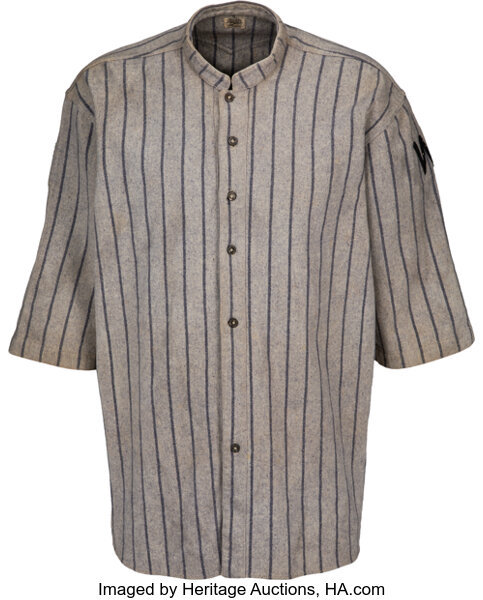
Countless offerings among the almost 3,200 available in Heritage’s May 16-18 Spring Sports Catalog Auction could serve as its centerpiece, its highlight — that one thing that belongs in a museum, if not a Hall of Fame. Like, say, the road New York Yankees jersey worn by Mickey Mantle during his final season in 1968, then signed and inscribed to a Yanks batboy. Or the photo-matched road Brooklyn Dodgers jersey Sandy Koufax wore during his rookie season in 1955 when he was not yet known as The Left Hand of God. Or the bat Ty Cobb used in 1922, his third — and final — season as a .400 hitter.
The list of must-sees and must-owns is seemingly endless, whether it’s a box of unopened Fleer basketball cards from 1961-62 or the pair of Adidas Crazy 8’s photo-matched to Kobe Bryant’s first All-Star Game in 1998. As has become tradition, the Spring Sports Catalog Event brims with the jerseys, sneakers, gloves, bats and helmets worn and used by some of sports’ most towering titans, from Willie Mays to Lionel Messi, Reggie Jackson to Gale Sayers, Warren Spahn to Tom Brady, Hank Aaron to Jim Plunkett, Carl Hubbell to Terry Bradshaw. The abundance of photo-matched jerseys in this auction alone qualifies it as historic, as do the cards featured throughout, among them a near-mint 1952 Topps Mickey Mantle, a gem-mint Ty Cobb from the fabled Black Swamp find and the only known Elgin Baylor Topps card from 1969 graded a perfect 10.
But to begin, the relatively plain flannel jersey in this auction — gray, pinstriped, a small “W” stitched into each short sleeve — draws the eye first. It’s also a century-old jersey that still has tales to tell.
Collectors have always known who wore it: Walter Johnson, who spent all of his 21 seasons in the sun as the right-handed hurler for the Washington Senators. Johnson’s name is stitched into the collar in red cursive, just below the A.G. Spalding & Bros. label. We’ve always known, too, when Johnson wore it: during the 1919-1922 seasons, when the man sportswriter Grantland Rice called “The Big Train” was teammates with another right-handed pitcher, Eric “Swat” Erickson, to whom Johnson gifted the jersey upon Erickson’s retirement from the big leagues following his 1919-1922 stint with Washington.
Only days before this auction opened, Resolution Photomatching determined that the “one-time king of pitchers” — as Johnson was called in 1933’s Who’s Who in Baseball – wore this very jersey on April 29, 1920. That’s when the Nationals downed the New York Yankees 2-1 in front of 5,000 at the hallowed Polo Grounds.
Johnson recorded eight strikeouts that spring afternoon in New York, two coming against a newly minted Yankee right fielder named Babe Ruth, who recorded just a single hit (and RBI) against Johnson. The Big Train, who batted last in the Nats’ lineup, also got a hit that afternoon — a triple. In his 1920 book The Home-Run King, Ruth wrote that Johnson was “the best of them all.”
Earlier this month, Resolution photo-matched the jersey to a photo distributed by news agency Underwood & Underwood, whose caption heralds Johnson as “the unsurpassable speed twirler of the Nationals.” The photo also notes that Johnson’s “remarkable speed ball aroused all balldom several years ago” and that he pitched against the Yankees that April afternoon “with the same ‘pep’ that characterized his name.”
Two known Johnson jerseys have survived his storied career, during which The Big Train recorded 3,509 strikeouts (putting him at ninth on the all-time list), 417 wins (the most all-time behind only Cy Young’s 511 victories) and 110 shutout wins (still the record). One, from 1927, is on display at the Baseball Hall of Fame in Cooperstown, New York. The other is in this auction.
“We have had the opportunity at Heritage Auctions to offer some incredible and museum-worthy jerseys over the decades,” says Chris Ivy, Director of Sports Auctions at Heritage. “But this Walter Johnson example, photo-matched to his first dual with the great Babe Ruth in Yankees pinstripes, certainly qualifies it as a cream-of-the-crop rarity.”
0 notes
Text
youtube
Göring's Hero Nephew - Mercenary in Ethiopia, Finland & Biafra
Mar 3, 2024
Hermann Goring's nephew Count Carl Gustaf von Rosen led an extraordinary life - he was a Red Cross pilot in Ethiopia in 1935 and a bomber pilot in Finland in 1939. He helped create the Royal Ethiopian Air Force in the 1950s, and was a UN pilot in the Congo. He created a mercenary squadron in Biafra in the 1960s, battling Nigeria, and flew aid into Ethiopia after the Communists took over. Find out his full story here!
Credits: US National Archives; Library of Congress; Jorchr; Akseli Gallen-Kallela; Swedish Army Museum; Eric Gaba; David Castor
0 notes
Text
bury me at eric carle museum of picture book art
1 note
·
View note
Text
MHC #171 The Space Museum 2.7
DULL:
Welcome to Mostly Harmless Cutaway One Seven One featuring Caleb, and Eric. Join us as we dive into our continuing series for the podcast where we use a randomiser to select a story from any Era of Doctor Who. This time focused on the First Doctor story, The Space Museum. Let the banter begin!
This is the first Hartnell story to be officially reviewed on MHC!
LINKS:
@SciFiPartyLine: scifipartyline.com
@ProgNeg: prognosisnegative.libsyn.com
@StarTrekRBG: startrekrbg.libsyn.com
Mostly Harmless Cutaway Patreon: patreon.com/MHC
WARNING:
This discussion contains miscellaneous K-9 and Company, Torchwood, Sarah Jane Adventures, Sherlock, Class, new WHO, and/or classic SPOILERS pertaining to Doctor Who. If you are 100% spoilerphobic to new & classic episodes not yet seen, do NOT complain to us. This episode is MOSTLY HARMLESS & contains EXPLICIT ideas, and as always expect strokes of innuendo throughout.
DISCLAIMER:
This episode was recorded on May 11th, 2023.
COMING SOON: MHC #171 ??
DON'T PANIC
Host/Producer: Eric @BullittWHO Email: [email protected] ProgNeg: prognosisnegative.libsyn.com
Co-host: Josh @whomeJZ Email: [email protected]
Co-hostess: Cat @fancyfembot Email: [email protected] Sci-Fi Party Line: scifipartyline.com
Co-host/Producer: Caleb
@Calebalexader
https://thenoviceelitists.podbean.com/ Podcast: https://tnebendingtheelements.podbean.com/
Mostly Harmless Cutaway @DoctorWhoMHC Email: [email protected] Website: guidetothewhoverse.libsyn.com
Tumblr: doctorwhomhc.tumblr.com Facebook: facebook.com/DoctorWhoMHC Art: H.B. Lockwood @hayleyglyphs
Legal: Sean H. @tardistavern
Iconoclast: Katrina G. @xanister
PR: Kyle A. @FunctionalNerd
Comptroller: Chris B. @dubbayoo
Robotics: Carl L. @robominister
Eponymous opening by Emily K. @emilyooo White/Red MHC logo by @DrWhoLetTheDogs MHCTheme created by E.A. Escamilla
Check out this episode!
0 notes
Text
This is so close to the Eric Carle Picture Book Museum, do yourself a favor and make it a double-header.
561 notes
·
View notes
Text
While we’re remembering Eric Carle’s legacy, consider supporting the Eric Carle Museum of Picture Book Art. It’s a small nonprofit museum that Eric Carle and his wife founded, and it’s dedicated to promoting anti-racist education and marginalised voices.
If you’re not in Massachusetts, their online gift shop is wonderful too! They have a great selection of underrated picture books (I love their AAPI stories and LGBTQIA+ collections), plus art prints, posters, clothes, etc. They even have Eric Carle themed fabric! Just look at this shit and tell me you don’t want A Very Hungry Caterpillar themed quilt.
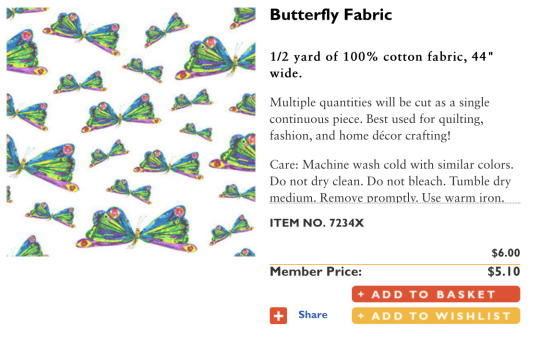
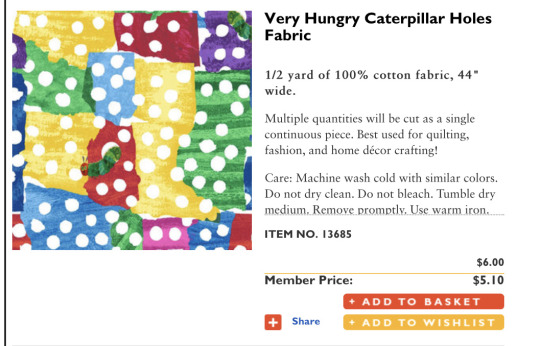
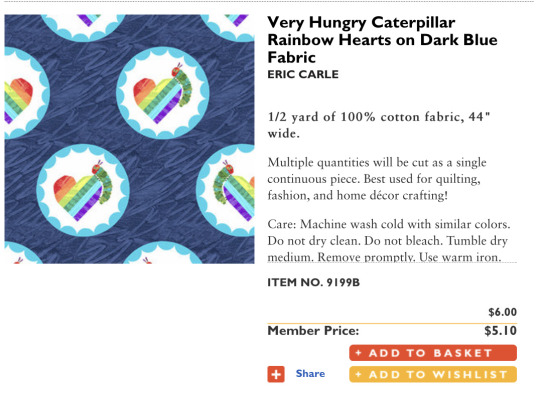
The caterpillar is gay now. We called dibs.
#Eric Carle#Eric Carle Museum#seriously#it’s awesome check it out#personal#ok to reblog#actually please reblog this museum is so underrated
20K notes
·
View notes